From the scrolls of Ancient Egypt to the books first printed on the Gutenberg press, and now in the ones and zeros of digital data, the wealth of human knowledge has always been stored in libraries.
But these days, libraries are a lot more than just a place to check out books and do research.
The libraries of today are community gathering centers. They stand for the universal truth that knowledge should be free and accessible to all, no matter the format in which the knowledge is stored.
So trust us when we say modern librarians are no longer the fastidious rule-followers of yesteryear. Instead, the librarians of today stand at the crossroads of an exciting future — mixing the best of the past with an innovative future.
A degree in library science will put you in the middle of it all. Find out all you need to know in this ultimate guide to a career and degree in library science.
What Is Library Science?

If you love to read, chances are at some point in your life you fantasized about working in a library, spending all day reading and organizing books.
To work as a librarian in a public or public school library most often requires a master’s degree in library science.
Some students earn a Bachelor of Science (BS) in Library Science before continuing on to complete their Master of Library Science (MLS) or Master of Library and Information Science (MLIS). However, a bachelor’s degree in library science is not required to attend most graduate-level programs in library science.
While conducting your research, you may find that some schools refer to library science by a slightly different name. Those names include library studies, bibliothecography, library economy, and informatics. But no matter what the library science program is called, the outcomes are similar.
While a love of reading and literature are important parts of library science, they’re just one small part of the degree, and those two attributes are also just one small part of a career in library science.
The truth of the matter is, while library science is a great choice for those who love to read, it’s also a great choice for anyone with voracious intellectual curiosity and a drive to help others.
Those who major in library science study much more than just literature and the Dewey Decimal System. They also study management, information technology, and education.
Library science majors also study the fair distribution of knowledge within a society, as well as the best techniques, approaches, and philosophies surrounding the collection, organization, and preservation of all sorts of information resources. That’s because libraries have moved beyond books and into the world of digital data and digital information distribution.
Many enroll in master’s degree programs in library science with a bachelor’s in English, literature, writing, education, journalism, or a related field. Your options are open, so long as certain prerequisites are satisfied.
Additionally, library science degrees are commonly offered in the traditional classroom setting, online, or in a hybrid model.
Some ambitious students continue beyond a master’s degree, earning a PhD in Library Science, sometimes called a PhD in Information Science, or a PhD in Library and Information Science.
No matter the degree, each step along the way opens a whole host of career opportunities, which we will outline a bit later in this article.
Bret Christensen completed an online MLIS program from San Jose State University in 2004. He now runs the blog LegalResearchisEasy.com.
“A library science degree is a tremendous asset for professionals as well as bookworms,” Christensen tells Online Schools Report.
“Specialty libraries, such as medical and law libraries, need people who not only understand the resources and how to find them but also the practical application of the information in the profession,” he says.
“These folks are like gold to a library!”
But don’t just take our word for it, or for that matter. For a complete picture, consult just one of the many library science-related professional organizations, like the American Association of Law Libraries (AALL), the American Association of School Librarians (AASL), or the Association of College & Research Libraries (ACRL), among many others.
In our next section, we’ll take a closer look at just a few of the many careers made possible by a library science degree.
Careers in Library Science
Although working as a librarian is the ultimate goal for many who study library science, it’s just one career outcome of the degree. Library science majors also go on to become children’s librarians, to work in information architecture and taxonomy, or to work as law librarians, to name just a few exciting careers made possible by this field of study. Keep reading for a complete picture of the careers listed below.
| Job Title | Approx. # Years of Education | Average Annual Salary |
| Librarians | 6 | $59,500 |
| Database Administrators | 4 | $93,750 |
| Computer Network Architect | 4 | $112,690 |
| Library Technicians and Assistants | 2 | $30,560 |
| Archivists, Curators, and Museum Workers | 6 | $49,850 |
All salary data is courtesy U.S. Bureau of Labor Statistics Occupational Outlook Handbook.
Librarian

Naturally, many who study library science have one objective in mind: to become a librarian, sometimes called media collections specialists. These days, though, librarians are a far cry from the fussy and fastidious old men and women telling us to shush when we speak above a whisper.
Although organizing and cataloging physical media such as books, DVDs, and CDs, is a big part of the job, in today’s world, librarians do much more than just that. They also curate databases of information while helping patrons conduct research, source research materials, and evaluate research results.
Another part of the job of a librarian is to stay abreast of publishing trends through reviews, publisher announcements, and catalogs. This is all while keeping the library collection fresh and up to date with material across a variety of formats, including but not limited to books. Librarians may also plan programs for all ages, teach classes, and train staff.
Developing and managing budgets may also be part of a librarian’s job. So, too, can be purchasing new computer equipment for both library staff and patrons.
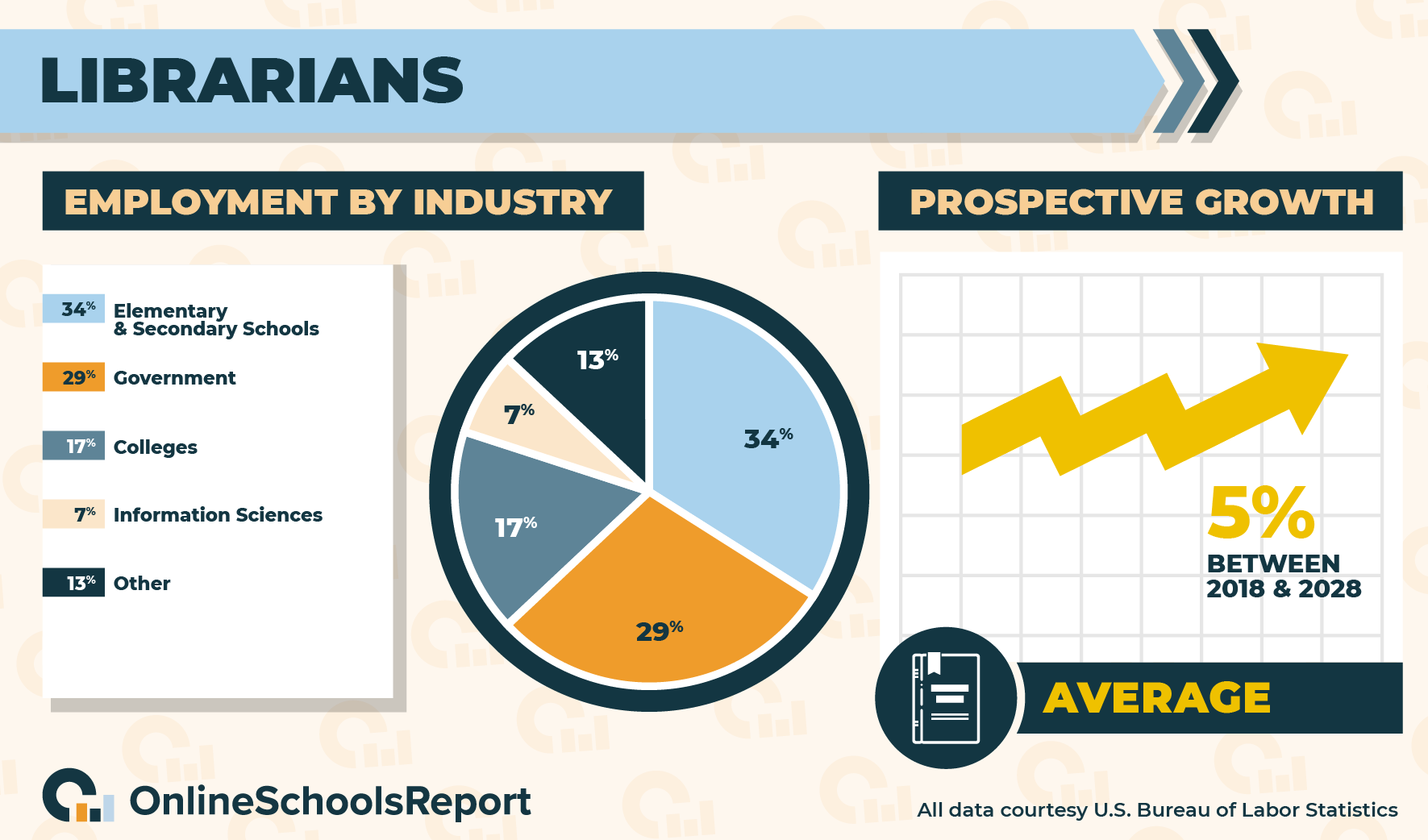
It’s also important to note that there are more than just one kind of librarian.
That list can include academic librarians, public librarians, and school librarians, to name just a few.
While these jobs are similar, each has a speciality, and the educational requirements vary for each. Most often, a librarian needs at least a Master of Library Science (MLS) or Master of Library and Information Science MLIS).
Public school librarians often need a teaching certificate and specialty librarians such as law or medical librarians may need an additional degree or proof of experience within that area of expertise.
It’s important that the program you choose to attend is accredited by the American Library Association.
According to the Bureau of Labor Statistics, librarians make on average a little less than $60,000 dollars a year. BLS data also states there are roughly 147,000 librarian jobs in the U.S, and that number is expected to grow at a rate of 5% in the decade spanning 2019 – 2029. That’s an above-average rate of growth for many professions.
Also according to the BLS, 34% of librarians work in elementary and secondary schools, while 29% work for the government. Following that, 17% work for colleges and 7% work in the information sciences. Good states to live in for librarians include New York and California.
Database Administrator

What is a library if not a database, and database management, combined with a library science degree, is a useful skill in all sorts of professions and contexts. That includes the work — naturally enough — of a database administrator.
Moreover, coupling a library science degree with a degree in computer or information sciences is a common path for many database administrators.
In their daily work, data security and the prevention of data loss is a primary concern for a database administrator. As is backing up, storing, and restoring data.
Database administrators may also test or modify databases as required. Maintaining the database and updating permissions and other methods of access is also part of the job. The work can also involve updating and merging old database information with new formats and platforms.
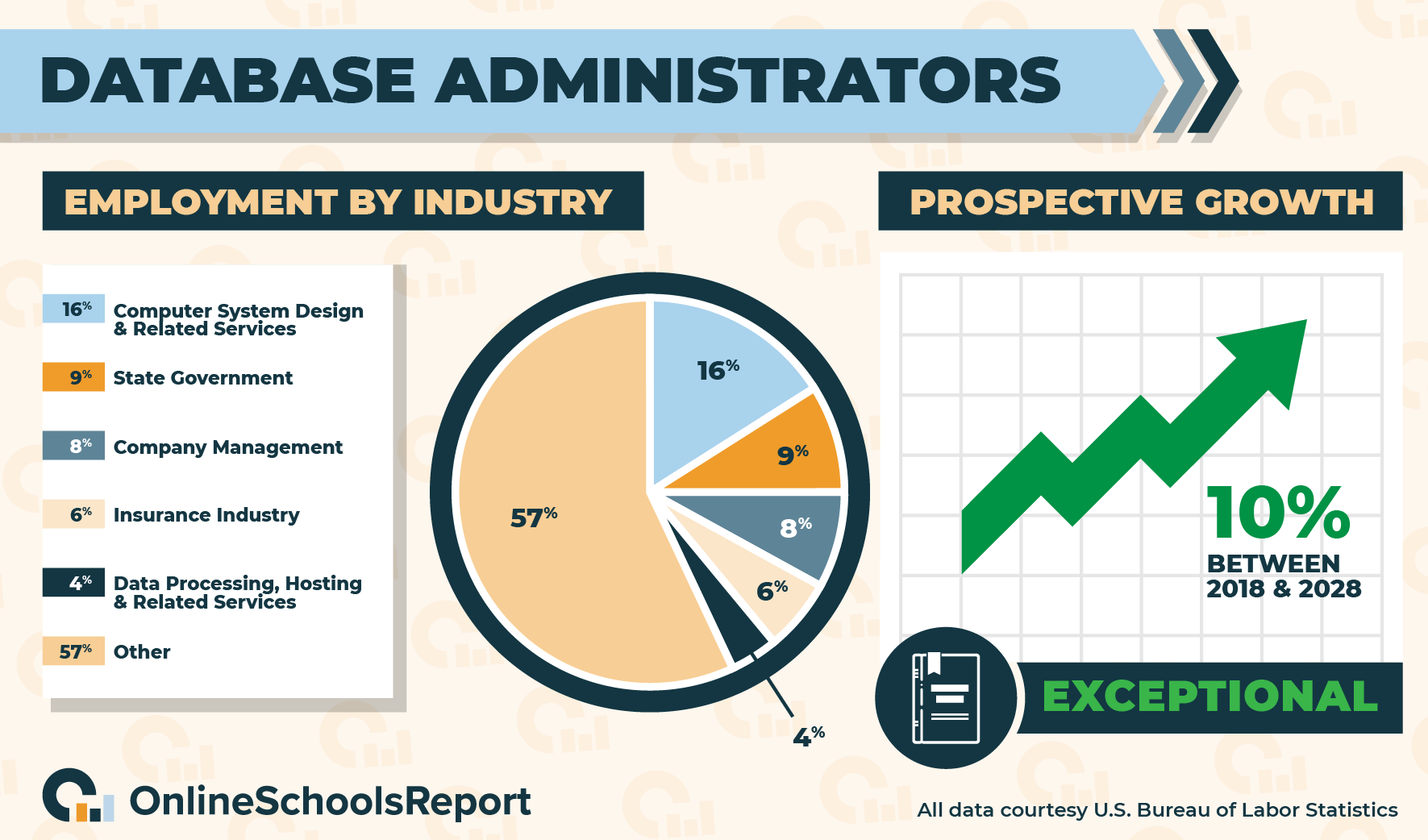
Educational requirements differ across the various kinds of database administrators — including system DBAs, who are responsible for the physical and technical aspects of a database, and application DBAs, who provide provide database support for specific applications.
A bachelor’s degree in computer or information science is most often the minimum requirement to enter this field, but many combine a degree in library science with an advanced degree in computer science, or some combination thereof.
Additional certification is also offered from specific software vendors or vendor-neutral certification providers, such as the Microsoft SQL Server database certification.
According to the Bureau of Labor Statistics, database administrators make about $94,000 dollars a year, and there are 133,000 jobs for database administrators across the U.S. The BLS projects that number to grow by 10% in the years ranging 2019 – 2029, which is about twice the average rate of growth across all professions.
Also according to the BLS, 16% of database administrators work in computer system design and related services, 9% work in educational services, and 8% work in company management. Following that, 6% work in the insurance industry, and 4% work in data processing, hosting, and related services.
States with strong employment numbers for database administrators include California and Texas.
Computer Network Architect

If a library is something of an information database, the functioning of a library is not so different, then, than the functioning of a computer network. A library is, in many ways, an information system, leading to many schools adding information science to the title of their library science degrees.
This emphasis leads many who study library science, and especially those with additional coursework in computer science, to go on to work as computer network architects.
Computer network architects build data communication networks, such as intranets, local area networks (LANs), and wide area networks (WANs). The first step is to create plans and layouts for data communication networks and then present those plans to management.
Computer networks are a vital part of an organization, and a computer network architect must feel confident their plan is the best path forward.
Ensuring network security is also part of the job. So, too, is upgrading both the network’s hardware and software like routers, adaptors, and drivers.
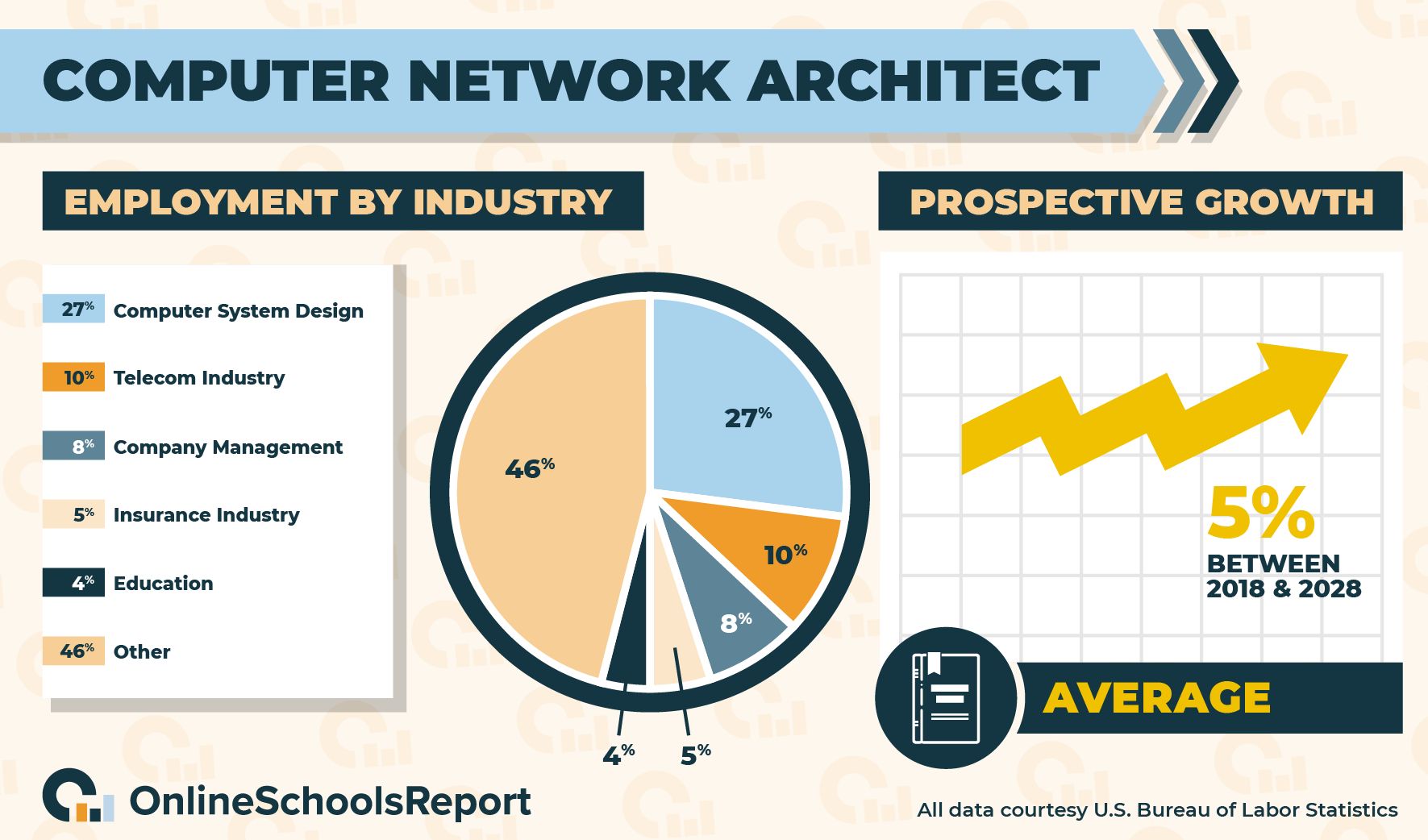
According to the Bureau of Labor Statistics, computer network architects make about $113,000 dollars a year, and there are a little more than 160,000 network architecture jobs across the U.S. That number is expected to increase at a rate of 5% in the years spanning 2019–2029, which is right in-line with many other professions.
Data from the BLS also states that a bachelor’s degree is most often the minimum educational requirement to become a network architect, and that degree is usually paired with computer science or information science.
Up to ten years of experience as a network and computer system administrator is also a common condition of employment, and professional certifications such as Cisco Certified Network Associate (CCNA) can also help boost employment opportunities.
As far as the work environment of computer network architects goes, 27% work in computer system design, according to data from the BLS. That’s while 10% work in the telecommunications industry and 8% work in company management. Following that, 5% work in the insurance industry, and 4% work in education.
Good states to live in for network architects include California and Texas.
Library Technicians and Assistants

Like we said earlier, many who study library science naturally want to work in libraries, and there’s more than ways to work in a library than just as a librarian. Such jobs are often called library technicians and assistants, and they are frequently entry-level positions for future librarians.
In their work, library technicians and assistants help with general library operations, including loaning and returning material, as well as shelving returned books, periodicals, and media of other formats. Other tasks include maintaining and updating the library catalog.
Library technicians and assistants may also handle interlibrary loans, register new patrons, and issue library cards. Customer service duties can also be part of the job description for a library technician or assistant, answering reference questions, teaching patrons how to use library services, and maintaining computer library databases.
Clerical duties are also commonly performed by library technicians and assistants. They also participate in, plan, and coordinate special library events and programming.
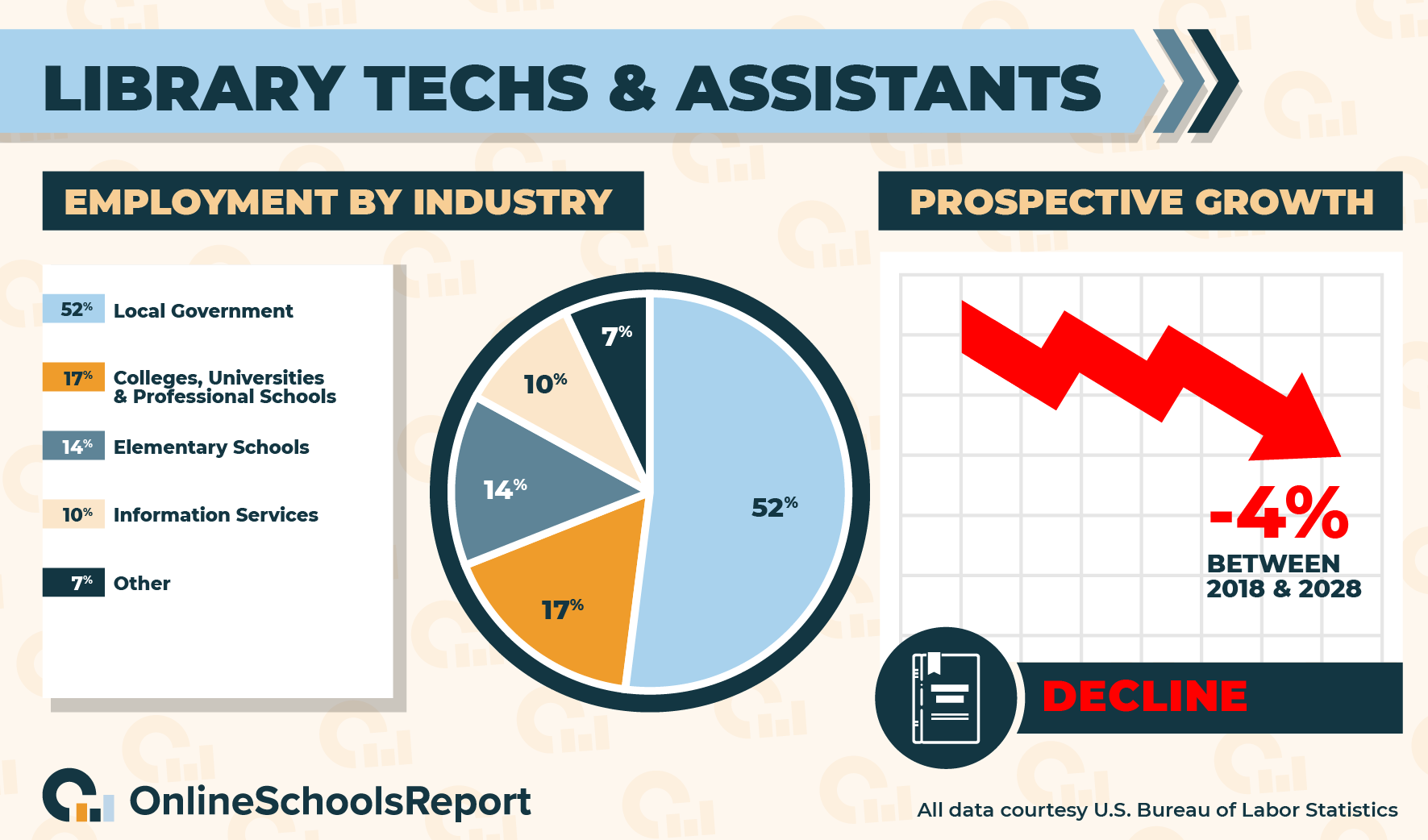
According to the Bureau of Labor Statistics, library technicians and assistants make a little less than $31,000 a year. There are about 185,000 jobs available in the U.S., but that number is expected to decline at a rate of 4% in the decade spanning 2019 – 2029, making it a competitive job market.
Also according to the BLS, the minimum educational requirements to become a library technician or assistant is a high school diploma and possibly a postsecondary certificate in library technology. Postsecondary library science degrees will improve advancement opportunities.
More information about becoming a library technician or assistant is available from the American Library Association.
Also according to the BLS, 61% of library assistants work for local governments and 14% work at colleges, universities, and professional schools. Following that, 11% work in schools at the elementary level, and 9% work in information services in other contexts.
That’s while 52% of library technicians work for local governments and 17% work for colleges, universities, and professional schools. An additional 14% work for schools at the elementary level and 10% work in information services. States with strong employment numbers include California and New York.
Archivists

Work as an archivist is also a common career path for those with educational backgrounds in library science. In this career, archivists, classified by the Bureau of Labor Statistics alongside curators and museum workers, handle, organize, and catalog a broad range of archival materials, including but not limited to historical documents.
They also preserve a wide variety of objects and documents, oftentimes of historical value, while also developing and maintaining digital records.
Archivists may also direct and supervise colleagues and subordinates in the archival process, while setting and administering policies related to public access of the items, data, and information. Archivists may also find and acquire new material for the collection.
Many archivists have an area of expertise or work with specific documents. For example, some archivists work with manuscripts, electronic records, and websites. That’s while others may specialize in photographs, maps, motion pictures, or sound recordings, according to the Bureau of Labor Statistics.
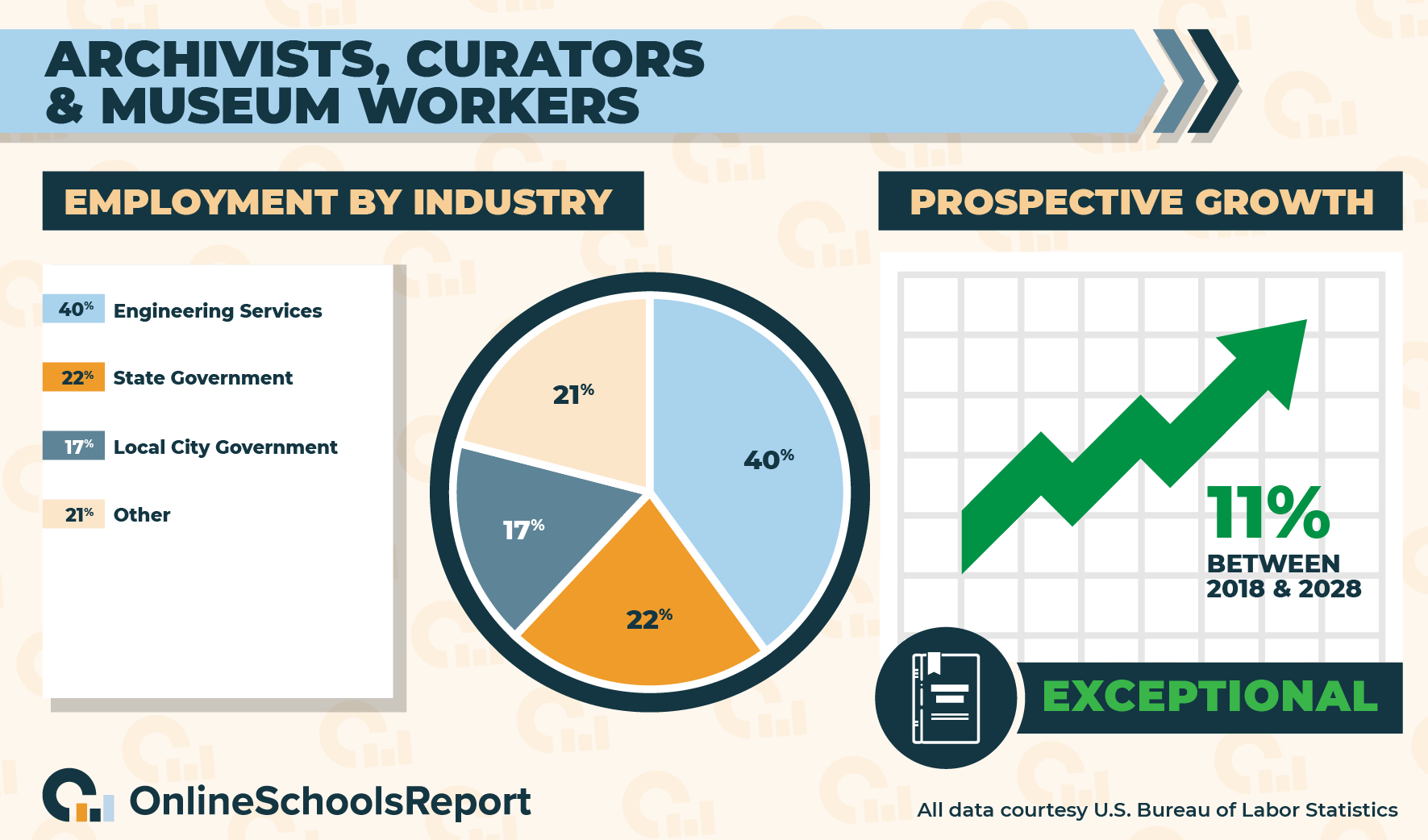
Also according to the BLS, archivists, curators, and museum workers make on average a little less than $50,000 a year, and there are just about 38,000 jobs across the U.S. The BLS projects that number will grow at a rate of 11% in the decade spanning 2019 – 2029, which is about twice the average rate of growth for other professions.
As far as minimum educational requirements, the BLS states that most archivists hold master’s degrees in subjects like history, archival studies, political science, public administration, or library science. An additional professional credential for archivists is offered through the Academy of Certified Archivists.
Large organizations offering in-house training for archivists include the U.S. National Archives and Records Administration, located in Washington, DC.
Data from the BLS also declares that 40% of all archivists, curators, and museum workers are employed by museums, historical sites, and other similar institutions. Following that, 22% work for the government and 17% work in educational services. States with strong employment numbers for archivists include California and New York.
Library Science Degrees
Ready to start your career in library science? The first step is a degree. Below we’ll outline the various degrees available in library science, with information about careers made possible by each degree every step of the way.
Associate’s Degree in Library Science

An Associate of Arts (AA) Library Science degree is often the first step for anyone seeking a career in library science. These degrees are also sometimes called an Associate of Arts in Library Technology, while some schools offer an Associate of Science (AS) in Library and Information Science, or some variation thereof.
Awarded by junior and community colleges in-person, online, and through a hybrid model, these degrees prepare students to transfer credits to a 4-year college or university to complete their Bachelor of Arts degree in Library Science or to find work as a library assistant or technician.
In addition to general education, library science associate degrees cover topics like care of library materials, library acquisitions, and library technical services. Other subject matter can include library media services and library automations. Successful students will also be comfortable working with computers.
An associate degree in library science primarily prepares graduates to work as library technicians or assistants, though earning potential and career advancement opportunities holding only an AA or AS in library science may be limited.
A high school diploma with transcripts and a minimum GPA of 2.0 is a common prerequisite for any associate degree program, though these requirements may vary. Most associate degrees require the completion of 60 course credits to graduate. That’s about 20 college courses, and this takes many students about two years to accomplish, though this too can vary.
Bachelor’s Degree in Library Science

After completing an associate degree, many students move on to earn their Bachelor of Arts (BA) in Library Science, referred to by some schools as a Bachelor of Arts in Library Science and Media. Another degree option at the bachelor’s degree level is a Bachelor of Science (BS) in Library and Information Science.
Each degree option provides a slightly different area of emphasis, but all are multidisciplinary degree programs, encompassing subject matter such as new technology, education, and how knowledge is organized and fairly distributed within society.
Areas of concentration within a bachelor’s degree program in library science can include children’s education, multimedia and data collection, and many other subjects. In addition to general education, coursework in a bachelor’s degree program in library science can range from library management and leadership to research methods and media for children.
It’s important to note that a bachelor’s degree in library science will not qualify a graduate to work as a librarian at a public, school, or academic library. Earning a bachelor’s degree is simply the first step in earning a master’s degree in library science (MLS) or master’s degree in library and information science (MLIS), most often the minimum educational requirement to become a librarian.
A bachelor’s degree in library science, however, does qualify a graduate to work as a database administrator or computer network architect, among many other compelling careers.
An associate degree or high school diploma with transcripts and a GPA of 2.0 is most often the minimum entrance requirement for a bachelor’s degree program, though admission requirements may vary. Submitting SAT or ACT scores may also be required; as can letters of recommendation or a statement of personal intent.
Most bachelor’s degree programs require about 120 credit hours for completion, or about 40 college courses, with a GPA of at least 2.0, though minimum GPA requirements may vary.
That takes most students about four years to accomplish. Programs are typically offered online, in the traditional classroom setting, or through a hybrid approach. It’s important to ensure that any program in library science is accredited by the American Library Association.
Bachelor’s degree programs in library science also prepare graduates to earn their public librarian certification, the technology specialist endorsement, or media specialist certification. Many graduates from library science bachelor’s degree programs also go on to earn their teaching certificate.
Master’s Degree in Library Science

As previously stated, to work as a librarian in most public, school, or academic libraries, one must have a master’s degree. Most commonly, that will be a master’s in library science (MLS), or master’s in library and information science (MLIS), though additional degree variations do exist.
The difference between an MLS and an MLIS can be summed up by an MLS providing an emphasis on the educational and operational side of library studies. An MLIS, on the other hand, focuses more specifically on new and emerging digital technology related to data distribution and hierarchy.
Otherwise, a master’s degree will build on the opening chapters of a bachelor’s degree, providing the opportunity for further concentration in specialized areas.
Coursework in a library science master’s degree program can include subjects and topics ranging from preservation and conservation to public library services and marketing. Most master’s degree programs require between 30 and 40 credit hours. That typically takes students about two years to complete.
Prior to applying to a program, prospective students should consider whether or not that program provides the areas of concentration in which they are most interested. The availability of internships, fieldwork, and practicum opportunities should also be a consideration.
Master’s degree programs also commonly require the completion of a thesis, typically developed in collaboration with a faculty advisor. A master’s thesis will require extensive research and preparation, and will be presented and defended before a panel of faculty members.
Non-thesis library science degree options do exist, so students should consider their preference before applying for a program.
A bachelor’s degree with transcripts and a 3.0 GPA is most often the minimum educational requirement to apply for any master’s degree program, though this can vary between programs. Letters of recommendation or statements of personal intent may also be required, as can GRE test scores. It’s important that your program is accredited by the American Library Association.
Doctorate’s Degree in Library Science

The closing chapter of an educational career in library science is most commonly a Doctor of Philosophy (PhD) in Library Science or Library and Information Science, though some degree variations do exist. A PhD in library science will lead to even further specialization than an MLS or MLIS. It will be a data-driven, research and writing-intensive course of study, with various concentration options such as building and maintaining information systems, data curation, and librarianship.
Most often those who pursue a PhD in library science are interested in teaching or researching at the highest levels of academia. PhD is rarely required to become a librarian at a school, public, or specialty library, though a degree of this level will set a candidate apart from the competition, and perhaps increase the likelihood of promotion into the upper levels of library management.
A terminal thesis that involves fresh insight and deep research will be required to complete most PhD programs. This thesis will be developed in conjunction with a faculty advisor and presented and defended before a panel of faculty and peers. Many PhD students also teach at the institution from which they are earning their degree.
Specific coursework in a library science PhD program can include statistics in the context of library and information science, qualitative and research methods, and teaching and learning. Internship and fieldwork opportunities are also common in PhD programs.
Otherwise, a master’s degree with transcripts and a GPA of at least 3.0 and GRE scores are the minimum application requirements for most PhD programs. That can also sometimes include letters of recommendation or a state of personal intent.
The average PhD takes about 90 credit hours to complete. That takes many students two or three years, though this can vary, and some students take much longer to complete their thesis while also teaching. Some of those credit hours will be in traditional classroom settings, while others will be completed in workshops and conferences.
Some PhD programs are available online, completely in-person, or through a hybrid model.





